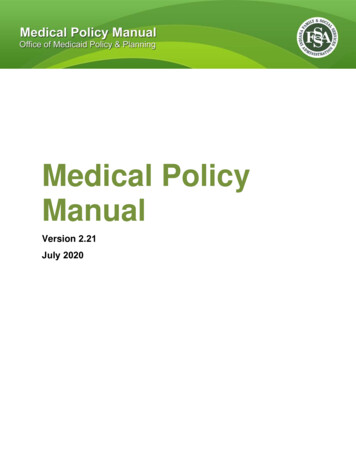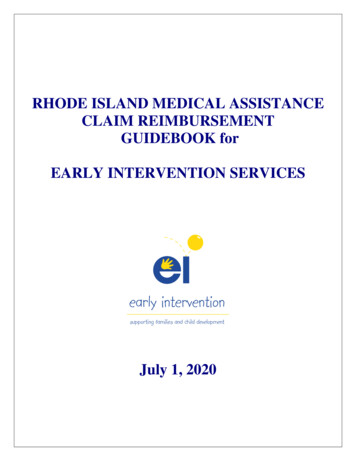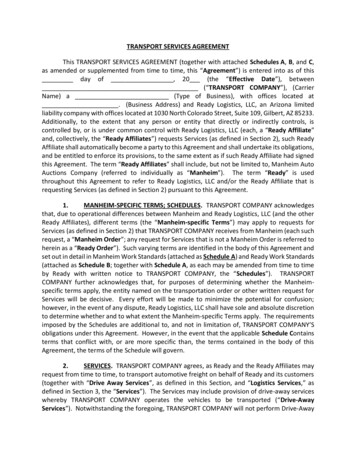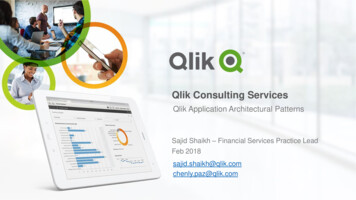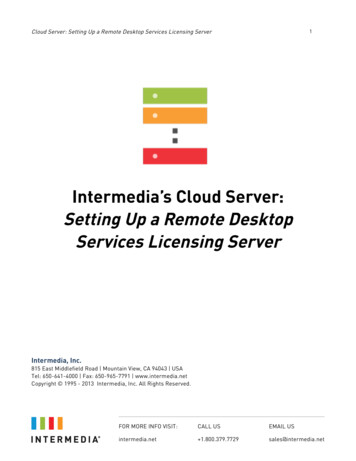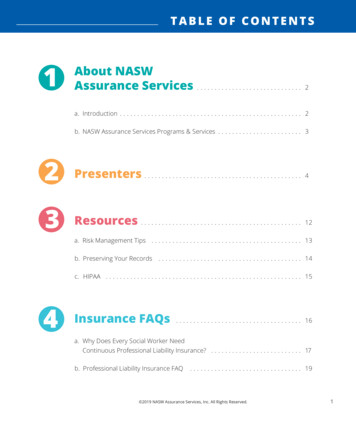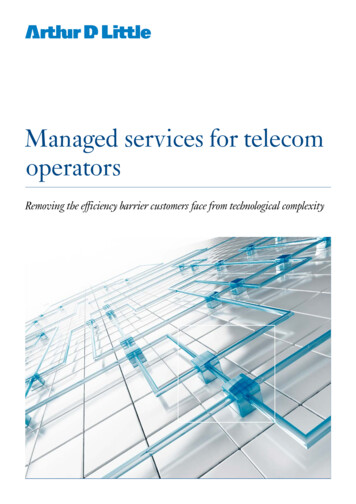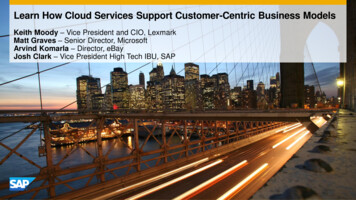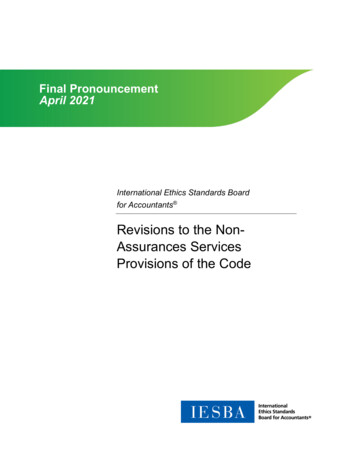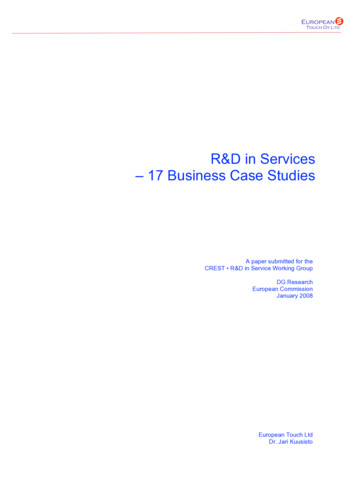
Transcription
R&D in Services– 17 Business Case StudiesA paper submitted for theCREST R&D in Service Working GroupDG ResearchEuropean CommissionJanuary 2008European Touch LtdDr. Jari Kuusisto
Contents1Introduction32Summaries of case studies on R&D in services52.12.22.32.42.52.62.72.82.93Belgium2.1.1 Vadis – analytical business intelligence consulting2.1.2 Creax – Patent research and idea generation2.1.3 Quality Assistance – contract research2.1.4 Defimedia SA - e-business, e-marketing, e-learning consultancy2.1.5 Telemis SA - Picture Archiving & Communication SystemDenmark2.2.1 BDO ScanRevisio – Accountancy and consultingFinland2.3.1 YIT GroupGermany2.4.1 CLAAS - agricultural engines and harvesters2.4.2 Deutsche Industrie Wartung (DIW)2.4.3 Drees & SommerGreece2.5.1 Singular Logic - Software and related servicesLithuania2.6.1 Maxima LT – retail tradeNorway2.7.1 Geelmyuden.Kiese (GK) - Strategic Communications ConsultingSweden2.8.1 Trial Form Support (TFS)2.8.2 Ekelöw InfoSecurity AB (Ekelöw)Turkey2.9.1 TURKTRUST (TT) - Information Security Services2.9.2 IES Education and Information Technology - Education solutionsSynthesis of case study findings and R&D in 28282933
1IntroductionThis paper presents the business case studies that were analysed as part of the R&D inservices work programme. These case studies are highlighting the real life businesspractices related to R&D in services in a range of different types of serviceenterprises. In addition to the specific nature of services related R&D attention will begiven to development challenges that analysed businesses have identified. Thisrepresents a partial contribution to the work carried out by the CREST R&D inservices Working Group. The overall aim of the Working Group is to advance theuse of R&D in service sector by exchanging information, identifying good practicesand developing policy measures and recommendations. In total 14 countries haveparticipated the R&D in services Working Group, and around 10 countries have beenmost active contributors to the work programme. The participant countries include:Belgium, Denmark, Finland, Germany, Greece, Iceland, Ireland, Lithuania,Luxembourg, Sweden, Turkey and the United Kingdom. The programme of theCREST Working Group includes the following elements that are reflected in thechapters of this paper:1. A review of existing literature and databases2. Survey of policy measures targeting the R&D in services activities in theparticipating countries3. Case studies highlighting the practices and development needs of R&D inservices in multinational enterprises – a task addressed in this paper4. Synthesis and policy implications for the promotion of R&D in services.As a whole this work will bring together latest research findings, business casestudies, brief statistical note, review of services R&D policy developments inparticipating countries and a synthesis as the final part of the report. As indicated inpoint 3, this paper presents 17 business case studies from 9 different countries,exploring R&D in services. The aim is to improve the understanding of the R&D andinnovation in services context across the range of different industries and in differentsize businesses (see Exhibit 1). A semi structured interview schedule was prepared toguide the interviewing process. The purpose was to allow sufficient context relatedflexibility while at the same time, it was important to have enough common ground toallow comparisons cross the cases. The interview themes included in the commonschedules we the following ones:1. Description of the case business and the way it has developed over the recentyears2. The nature and organisation of R&D activities in services3. Description of the R&D process in services from the idea to the market lauch,nature of development activities and R&D outcomes,4. Issues that could improve the R&D in services, existing bottlenecks, and e.g.available public sector measures and needs for any new types of interventions.For details, see Appendix 1, the interview schedule.3
Illustrative case studies serve an important purpose as they are grounding theliterature-based concepts presented in the earlier chapters. While cases will providevaluable complementary material for the report they will also offer an effective wayto communicate the key features of R&D in services to a wider audience. Finally,they will also demonstrate the heterogeneous nature of services and related R&D. Forinstance, in relation to sectors, size of the business and drivers of R&D andinnovation in services. Each case study will provide an analytical description ofservice related R&D in examined case business.Exhibit 1The details of the case studies on R&D in onsultingPatent research, idea generation,innovation studies, methodologicaltraining, new technical marketingstudies, and innovation softwareContract Researche-business, e-marketing, e-learningconsultancySoftware program for medical imagemanagement, and maintenancesupportAccountancy and consultingBuilding systems, construction,services for industry, networks and ITAgricultural engines and harvestersIndustrial maintenance and cleaningProject management and real estateconsultingSoftware and related servicesRetail tradeQuality AssistanceDefimediaTelemisDENMARKFINLANDBDO ScanRevisionYIT GroupGERMANYClaasDeutsche Industrie WartungDrees & SommerGREECELITHUANIASingular LogicMaxima LTNORWAYSWEDENGeelmyuden.KieseEkelöwTFSIES Education andInformation Tech. Inc.TURKTRUST InformationSecurity Services Inc.TURKEYNo. egic Communications ConsultingInfoSecurityClinical ResearchEducation solution provision7036300114Electronic certificate service providingand information technologies security30Exhibit 1 lists those nine countries that conducted in total 17 case studies thatanalysed a broad range of businesses as presented in the above table. The samplecovers a wide range of different types and sizes of services from construction, tosoftware and consulting, covering technology based (e.g. software) services as well astraditional services (e.g., retail trade).4
2Summaries of case studies on R&D in servicesThe full case reports are somewhat varied in nature and they extend from 3 pages to13 pages in length. The following sections will first display summaries of completedcase studies as well as some findings based on the semi-structured interviews thatwere conducted with the business representatives.2.1BelgiumThe contribution from Belgium comes in the form of five compact case studiespresenting businesses ranging from business intelligence, patent research and ideageneration, contract research, to e-business, e-marketing and e-learning solutions, toimage archiving and communication systems.2.1.1 Vadis – analytical business intelligence consultingVadis was founded in 2004 by the current managing director Thierry Van de Merckt(www.vadis.com ). The service offer of the business consists of analytical businessintelligence consulting and solution development. Vadis offers complete solutionsthat allow client businesses to understand their clients better, and to predict theirprobability to accept a commercial offer, or their probability to carry out activitiesthat pose a risk for the service supplier ( such as fraudulent insurance claims, abortingtheir contract, etc). At present the business employs 15 staff of which 5 are involvedin dedicated R&D team, 2 on part-time and 3 on full-time basis. In addition to humanresources R&D expenditures include computers, and contract work with universitiesand professors. The nature of the R&D is characterized by close relationship withbusiness projects, so it is very directly driven by business needs. Most of the timeVadis works closely together with clients marketing and sales departments. Othertypical features of R&D include: flat organization, cooperation between universitydoctors and programmers, algorithms exchange and development in connection withuniversity contacts. R&D plan and objectives are reviewed each months and budget isdirectly pending on the salary of the engaged people. Typical bottlenecks related tothe R&D in services include: finding the people with right skills.On average Vadis launches new services on the markets every two years time. Duringthe last 12 months period Vadis has been developing a new applications whichenables the navigation and presentation of the collaborative business activities aroundthe world. This is enabled by a new graphic clustering algorithm supported by the lastR&D project funded by ISRIB, Institute for the encouragement of Scientific Researchand Innovation of Brussels. For instance, combining IT skills and mathematics oradvanced statistical skills. Regional supports are considered most appropriate as theEuropean projects are seen as too complex for the business to handle.Typical feature of the Services R&D process project is that it involves good businessunderstanding of the problem that needs to be to solved, good vision on how to solveit and what will be out of reach. In addition, there is a need for excellent projectmanagement skills, people management, and the right set of skills. Typical stages inthe (software) R&D process include:5
identification of the business opportunityspecification of the development projectproject planningformulation of the R&D budgetfollow-uptesting, and finally beta test on real problemsThe key skills needed in services related R&D process management include vision ofthe potential outcome, technological skills, and program management capabilities.Our own work as consultants is the most common source for new ideas. R&Doutcomes are most of the time gradual improvements, while more drastic changes aretypical when the vision emerges from a totally new ground, i.e., from the white page.The external resources that Vadis makes use in its services R&D process includeUniversities resources and outside researchers who are contracted to do some work.Typical outcomes of the R&D include: new technologies, e.g. software tools enablingnew types of services, new type of service offer / service products, as well as entirenew types of business models. IP protection is important since competitors seek toimitate new services immediately, and often they also try to hire people from ourR&D team. Best ways to protect IP include fast innovation cycle, high enough R&Dbudget and law suites in case of infringements.Improving the performance of services related R&D. The main improvements that thecurrent services R&D process could benefit from include short R&D programs afterstudents have first graduated. There people could learn how to perform R&D, andthis does not mean a full scale PhD course but a shorter sorter period where peoplecould learn skills relevant for the R&D. Public authorities could promote R&D inservices by offering supports for the R&D as the regional agency IRSIB does. Theycould also facilitate and create synergies between innovative businesses by creatingdedicated meeting spaces for them, by promoting interaction and exchanges betweeninnovative businesses more generally, and by offering help to innovative businessesso that they would be better able to export heir knowledge based services.2.1.2 Creax – Patent research and idea generationCreax was started in 2000 by the managing director Simon Dewulf and it initiallystarted out as a research programme on ‘how to make engineering education morecreative’ (www.creax.com ). CREAX analyzed all innovation methodologies (TRIZ,FA, QFD, DFMA) as a starting point of the research, from which it developed its owninnovation methodology that is being utilized today as a way to solve problems,generate innovations and to find new markets. Initially the service offer by Creaxincluded patent research, idea generation, innovation studies, methodological training,marketing studies for new technologies, and innovation software. Current offerincludes also professional services for all the above-mentioned domains, whereasinitially mechanical engineering made about 80% of all the business. Currentlyservices make about 70% of the Creax income, and they ensure a stable income andgrowth. However, services do not entail similar a leverage effect as manufacturing, asthey are linked to the billed hours. At present, the business employs 20 staff of which16 are involved in the R&D, all of them on full time basis. In addition there are 2contracted out persons working in the services R&D. Current R&D expenditures6
include human resources, patent databases, servers, scientific literature, software, andtraining related costs.The nature and organisation of services R&D activities. R&D in services has beenorganized so that Creax seeks to employ staff with a wide range of knowledgebackgrounds so that the problems can be solved utilizing different angles ofknowledge, i.e. chemistry, mechanical engineering, etc. The R&D team has a set ofobjectives and budgeted resources. Typically the objectives are guided by the ongoing project work so that the specifications emerge from the research projects. Theclients of Creax can benefit from the national and European level public support forR&D and Creax is also assisting them in finding the correct funding mechanism. Inaddition, Creax runs joint programmes with Universities on building tools for R&D.Creax also develops new services in interaction with the clients with the help of itspartners. This means Creax relies on R&D partnerships that are long-term relations innature. On average, Creax launches new or improved services on the markets every 6months time. Typical bottlenecks of R&D in services include lack of skilled peopleand time investments in the R&D tend to take place on cost time available for saleswork.The nature of the services R&D process. The key to success factor in the R&Dservice itself is the communication, interaction and integration with the partneringcompanies. This represents the way forward as the company seeks to limit its risk inthe Research activities, focusing resources more on the development type activities.Some typical stages in the R&D process can be identified. The first step is from noidea to good ideas: that is teh problem definition, patent research, functional analysis,idea generation with the CREAX methodology, evaluation of 150-200 idea concepts,and finally the feasibility analysis of the top 10 selected clients. The secondalternative is from good idea directly to cash, which is done within the companyitself. The key skills needed in services related R&D include: open mind,understanding of problems, creative skills, good analytical skills, communicationskills and ‘sharing of imagination’. Typical sources for new ideas includes a databasebuild by Creax on successful innovations [www.moreinspiration.com], and also thefunction database [http://function.creax.com], illustrating the CREAX methodology,as well as a systematic approach to idea generation. In a typical case it takes 7 -12months to develop a new idea and launch it to the markets. The outcomes of the R&Dprocess are typically both gradual improvements and more fundamental changes tothe existing services. Fundamental changes, and more radical innovations inparticular, are encouraged in Creax. External resources are used in the R&D processmainly, when the feasibility of an idea is examined, and technology suppliersrepresent a free resource available for feasibility studies. Typical outcomes of theservices R&D in Creax case include new markets, new intellectual property, andeventually new partnerships. Often competitors tend to imitate new services veryquickly, but service innovation needs to be seen as a continuous process and the realchallenge is to bring new services to market by the time others copy the previousgeneration. This creates another challenge linked to the return on investment forinnovations that have a very short life- time. In other words, how to make enoughprofit during the short life-time of the innovation. Imitators that offer services linkedto database research can be easily identified, however the better way around is toignore these copies and invest time in New Service Development rather thandefending the existing one.7
Improving the performance of services related R&D. The existing services R&Dprocess could benefit from 3 key factors that constitute successful innovation, theyare creativity (skills), knowledge (schools) and action (processes). In the futurecomputer-aided research will greatly enhance the speed and quality of R&D. Publicauthorities could promote existing successful models, and to make more fundingresources available for them. They could also introduce a step-by-step processoffering financial supports all the way from R&D stages to the launch of aninnovation. Since R&D is in the core of the European success, we need to planaccordingly. Research in R&D services is therefore a must.2.1.3 Quality Assistance – contract researchQuality Assistance – contract research business was established in 1982 by twofounders Philippe Draux and Philippe De Raeve (www.quality-assistance.com ).Initially the service offer of the firm included quality control services for the food,environment and medical sectors. At present the service offer consists of contractresearch exclusively for pharmaceutical and biopharmaceutical industries, and R&Dwork on medical products. Services play a key role in the business since QualityAssistance is R&D services provider. Competence, quality assurance, sensitivity andcommunication are therefore essential elements of the business. At present QualityAssistance employs 91 staff of which 11 are working in the services R&D, all on fulltime basis. In addition to human resources our R&D expenditures include premises,equipment and consumables necessary for R&D activities.The nature and organization of services R&D activities. Services related R&D in thefirm is based on continuous evaluation of the market needs. What is needed is anidentification of a potential innovation. Once this has been achieved, thedevelopment process will be started, validated by a scientific committee thatauthorizes and enables the R&D group to start the development of new services. Thecompany has R&D sections for each type of key activity including: physicalchemistry, biology, and bio-analysis. There are established objectives and budgetedresources for the R&D in services, and several highly qualified scientists work fulltime on the development of new analytical methods. Quality Assistance has benefitedfrom the regional level public support for services R&D. Public support was grantedin the in the form of a recoverable loan was provided by the regional developmentagency Research and Technologies in Wallonia (DGTRE) for the development ofphysicochemical methods for the characterization of biomolecules. In the past, thecompany has received support for employing personnel necessary for thedevelopment of technological innovations. New and improved services that havebeen launched on the markets during the last 12 months time include the full range ofservices concerning the analysis and characterization of macromolecules (activeingredients of the new generation of medicinal products i.e. biopharmaceuticals).Overall, new or improved contract R&D services are launched on the markets at anytime needed, depending on the evolving market needs. The three main bottle-necksthat are typical of R&D in services include: 1. Pressure to cut down developmenttime, 2. Shortage of skilled personnell, and 3. Lack of financial resources8
Services R&D process. Our typical services R&D project is based on a pool ofcompetences and structured organization in line with market needs. Typical stages inthe R&D process include: analysis of market needs, decision by Board of Directors investment in equipment and training and/or engagement of qualified personnelcommunication / marketing of new servicesOverall, the key skills needed in services R&D are competence in the subject fieldand ability to be responsive to markets. Universities are most important external R&Dresources that we use in your services R&D. Typical sources for new ideas include:clients, analysis of competition, and overall evolution of pharmaceutical products. Itcan take anything from 6 months to 3 years to develop a new idea and launch it to themarkets. R&D outcomes include both gradual improvements and also morefundamental changes to the existing services. Typical outcomes of our services R&Dinclude new laboratory activities required for the pharmaceutical andbiopharmaceutical industries (development of new medicinal products). In order toprevent copying of our services we make use of confidentiality agreements withcustomers and service providers. Also non-divulgation and anti-competitionagreements with personnel and external consultants are being used as a way to protectand manage out IP.Improving the performance of services related R&D. The key element that couldimprove the current services R&D process is the availability of skilled personnel.Public authorities could also promote R&D in services by improving financialincentives for businesses willing to invest in it. In the future we need to be capable ofdeveloping all analytical services complementary to our present activities, enabling usto propose a complete package of services required for the development of apharmaceutical product.2.1.4 Defimedia SA - e-business, e-marketing, e-learning consultancyDefimedia was established in 2006 as a merger of two businesses, Imedia andDefinition (www.defimedia.be/ ). Services have an essential role in the businesswhich consists of the development of multimedia solutions for e-business, emarketing, and e-learning. At present the business employs 20 staff, of which 4 areinvolved in services research and development, three as full-time R&D staff, and 1 onpart-time basis. In addition to human resources other R&D expenditures includepurchase of mobile technologies for testing purposes, for instance i-phones and GPSdevices.The nature and organisation of services R&D. In Defimedia. R&D is almost entirelycentered around the applied Atoms framework in JAVA environment. The R&D andevolution needs of this framework are formalized from information coming from: customers’ needs directly treated by our analysts and project managers; consultants’ analyses, and; technological watch on a permanent basis realized by persons involved inR&D9
There is a specialist R&D team of three developers in charge of the frameworkimprovements and they are all senior JAVA developers who have extensiveexperience in science and research. Delfimedia has a yearly R&D budget and itinvests around 50% of the profits to in the R&D. In terms of public R&D supports, ithas received financial assistance in 2003 to study and verify the technical feasibilityof its software framework. The source of this support was the regional developmentagency Research and Technologies in Wallonia (DGTRE). As a result of the activedevelopment work new or improved services that have been introduced during thelast12 months time include: PDF Editor/ creator capable of high quality printing, which is expandingDefimedia’s applications content on web as well as in PDF Development of a data base structure in hybrid XML and relational mode toallow Defimedia’s applications to structure heterogeneous data Automatic generator of AJAX files to allow Defimedia applications todevelop Web solutions in different modes E-bay solution integrationThe R&D objectives seek to secure that applications developed by the Defimediaallow the flexible development of multi-data, multi-devices, multi-formats orientedsolutions. These innovation’s time-to-markets is typical of software product cycle andDefimedia launches new or improved services every 3 months period, and majorreleases every 6 months period. Typical bottlenecks of the R&D in services includedifficulties in finding the skilled workers who have competency both in combininginformatics and some field of science. Since Defimedia’s framework is in use in thecustomer businesses, innovations need to be introduced on a permanent basis butwithout continuously interrupting their work processes.Services R&D process in Defimedia can be described through the typical stages of theprocess that include: Technological watch to identify technological fields with interesting future,and possibly as an emerging standard Discussions with partner organisations including universities Identification of customer needs or innovative ideas Decision to invest in a prototype Analysis and decision to incorporate the evolution into AToms frameworkThe key skills needed in services related R&D include people with: Scientific mind and curiosity, capacity to critically analyze marketinformation, competency to elaborate feasible working plan, willingness tofind a well performing and durable solution. Consultants capable of anticipating customers’ needs and trendTypical sources for new ideas include customers as well as university and industrialpartners, and it normally takes 6 months to develop a new idea and launch it to themarkets. R&D outcomes include gradual improvements as well as more fundamentalchanges to the existing services. Continuous minor improvements are necessary sothat we can keep up to with the competition as more radical evolutions normally bringspecific new features and value added to our solution. Defimedia does not useexternal R&D sources but it has permanent contacts with: academics at theuniversities, technical partners and customers. IP management in Defimedia is not10
currently using any protection tools since the software solution is available as opensource which means that the business needs to innovate continuously.The main improvements that the current services R&D process could benefit frominclude more frequent contacts with: University partners with interest in our activity fields: such as multi-modalinterfaces. Defimedia is trying to maintain contacts with some of the leadingprofessors from the best universities. These are providing access to moreextended network of experts. Industrial partners with a view on the market evolution. For instance,Defimedia is developing a relationship with SUN Microsystems.In addition to the closer interaction with academic institutions and clients the futuredevelopment needs include a number of new technological developments that will beneeded.2.1.5 Telemis SA - Picture Archiving & Communication SystemTelemis was established in 1999 by four founding partners as a business offeringinstallation services for Picture Archiving & Communication Systems (P.A.C.S.)which is a software program for medical image management (www.telemis.com ).Originally Telemis is a spin-off of the Université catholique de Louvain (UCL) inBelgium from its telecommunication and remote sensing Laboratory. Here theUniversity developed core competencies in image processing, distributed applicationsand security Infrastructure. The Laboratory became an actor in numerous national andEuropean projects (Fourth European FrameWork), and it also takes part in thedevelopment of international norms and standards. As a business Telemis is a globalleader in the filmless distribution of medical images. By utilizing the Telemisproducts and services, images can be shared efficiently and cost effective both withinand outside the hospital. Telemis-Medical is a modular and scalable solution that canbe integrated into your existing Healthcare Information Systems. It allows the clientto start using it without large investments needs. This is possible due to modularityand its client-server approach of the developed software product. Images can beshared inside the hospital (intra-muros) between the imaging departments and otherservices (ICU, etc.). Telemis-Medical also offers new opportunities for sharingmedical imaging devices (extra-muros). This service offer also includes maintenanceand support services for this technology. Services play a key role in the business as“High service standards” is an important differentiator and a key aspect ofcompetitiveness for Telemis. At the moment the business is employing round 30 staffof which 5 employees are working in R&D, 3 on full-time basis and 2 on part-timebasis. Besides human resources other R&D expenditures include equipment, andsoftware licenses.The nature and organization of services R&D activities. In terms of R&Dorganization there is an R&D unit, including one R&D manager, supervising a teamof 4 engineers. R&D meetings and updates are organized on a regular basis. Everyengineer has his/her personal objectives and on the business level Telemis typicallyinvests 8 to 10 % of its turnover into R&D. In terms of public R&D support, Telemishas drawn an interest bearing loan from the regional agency, Gateway to Researchand Technologies in Wallonia (DGTRE). New or improved services that have been11
introduced during the last 12 months time include one new version of software eachyear, plus new products such as mammography imaging software. On average, newor improved services are launched on the markets once or twice per year. At presentthe typical bottle-neck of R&D in services is availability of skilled personnel.Services R&D process. Typical stages in the R&D process, include ideas andsuggestions from the customers, followed by research including collaboration withuniversity(ies). Sources for new ideas include clients and sales force, in other wordscustomer interface is highly important for the R&D in services. Key skills needed inservices related R&D include flexibility combined with the knowledge of thesubstance area. Depending on the product/service, it takes 12-36 months to develop anew idea and launch it to the markets. The outcomes of s
case studies as well as some findings based on the semi-structured interviews that were conducted with the business representatives. 2.1 Belgium The contribution from Belgium comes in the form of five compact case studies presenting businesses ranging from business intelligence, patent
